Guernsey WWII mine 'a rare case' says bomb disposal expert
- Published
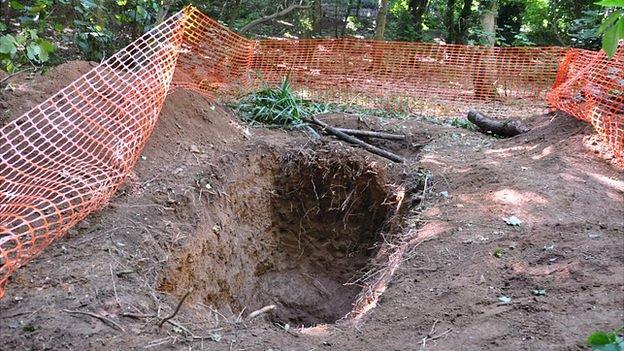
The hole left behind after the WWII aerial sea mine was dug out of Guernsey's Bluebell Wood will be backfilled by States Works
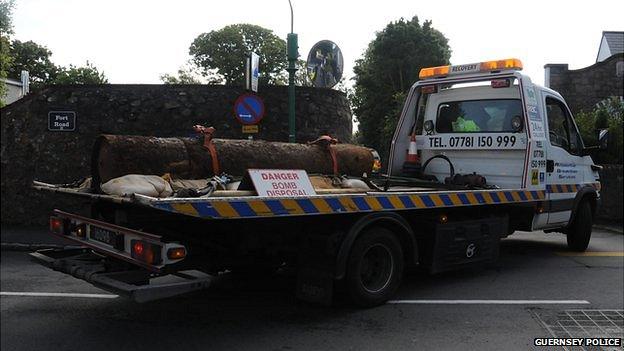
The mine was taken out of the woods by winch before being driven to Fermain Bay from where it was taken out to be detonated

Hundred of homes were evacuated and St Martin's Community Centre was staffed by volunteers from the Salvation Army providing tea and toast
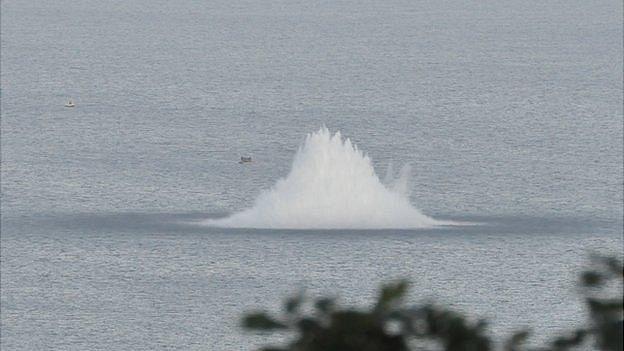
Hundreds of islanders lined the south coast to watch the detonation. Ahead of the explosion shipping and flights were diverted away from the site or delayed
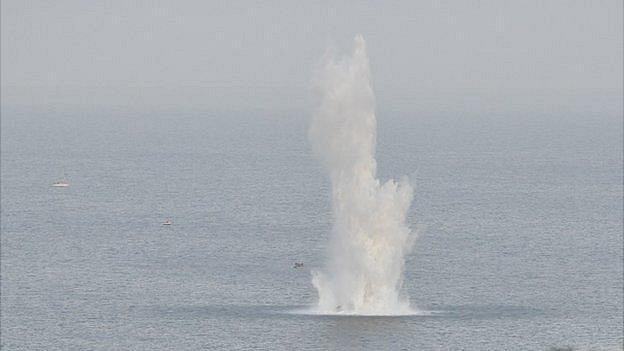
The 200m (650ft) high plume of water was the successful end of four days of work for the bomb disposal teams from the Royal Navy and Guernsey Police
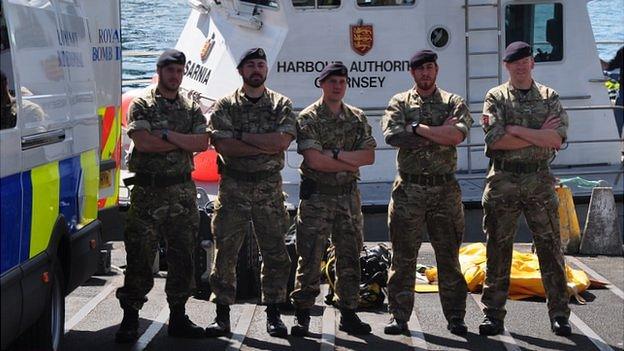
Petty Officer Nick Frost, far right, said the mine was "definitely the biggest task of my career so far"
The detonation of a World War II allied mine off the south coast of Guernsey was "a rare case", according to the head of the team behind its disposal.
A sea and air exclusion zone was placed around the aerial sea mine, which was detonated at 20:12 BST on Sunday.
The 850lb (385kg) device was found in the Bluebell Wood by police last week.
Petty Officer Diver Nick Frost, from HM Naval Base Devonport, said: "To find such a substantial munition so far away from the sea... is quite a rare case."
He said: "We do find a lot of land surface ammunition on training ranges, so small calibre stuff we deal with in the UK quite frequently."
He said the 12ft (3.7m) mine's position meant "a complicated logistics chain to get it into the sea".
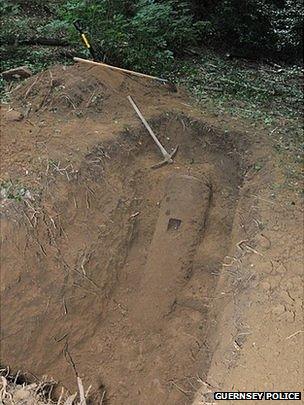
When the police discovered it was a British naval device from WWII the navy was called in
Hundreds of houses were evacuated as a precaution as the mine was moved out of the woods, on to a truck and down to Fermain Bay, from where it was taken out to sea for detonation.
The Leopardess fisheries protection vessel and the Sarnia harbour workboat kept a one mile cordon at sea while flights were suspended ahead of the explosion and Guernsey Airport remained open late to allow the delayed flights to land.
Hundreds of islanders lined the island's south coast in an attempt to watch explosion, which saw a plume of water forced in the air as the blast registered at Jersey's seismic station.
PO Frost said: "I'm not sure the guys are aware of the impact this has had on the island and the community.
"There's a greater interest here... we have seen some of the video footage from the cliff tops and there was quite an almighty cheer when it did high order.
"I'm sure when we're back and we look back we'll realise... how big an impact it's had and the guys will be able to stick their chests out and be proud of taking part in it.
"It's probably the biggest asset some of the guys will do, it's definitely the biggest task of my career so far and probably will be one of the pinnacles and high points."
Inspector Terry Coule said the mine had been discovered by an electronic locator being used by Guernsey Police's bomb disposal team during a training exercise in the area.
One among 74
He said the British Mark I ground mine was an anti-shipping mine designed to operate underwater and to arm after it was 12ft (3.7m) under the sea.
WWII mine detonated off Guernsey
Insp Coule said the Royal Navy experts were able to isolated the arming switch to allow the mine to be moved.
He said if it had had to be detonated where it was the exclusion zone would have been 2km, which would include the hospital and the whole of town.
Insp Coule was also involved in the clearing of a similar device, which was 500lb (226kg), from the wood in 1996.
John Goodwin, aviation historian, said the mine was among 74 aimed at St Peter Port Harbour during 18-23 June 1944 in a bid to stop the Germans from using it as a submarine base.
He said the island's occupying forces recorded that six fell on the land and had disposed of four. Now the fate of the other two had been cleared up.
Insp Coule said: "By finding the last of these six weapons that were dropped we've made the place a little bit safer."
- Published18 August 2013
- Published17 August 2013
- Published16 August 2013
- Published22 February 2012